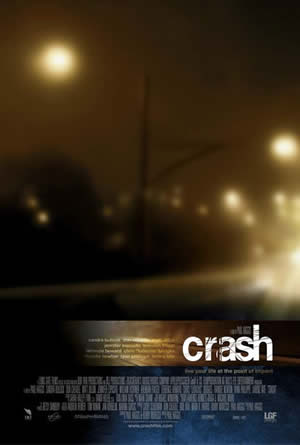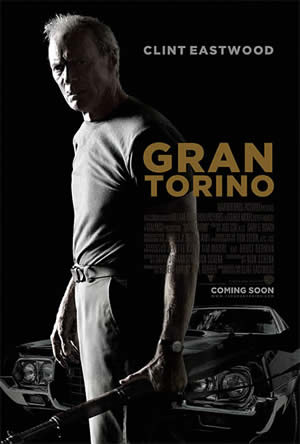A dual review of Crash (2004) and Gran Torino (2009)

 With the meltdown of the American economy since 2008, the further withering of employment in the almost vestigial manufacturing sector immigrants, documented or not, are likely to become scapegoats. It really won’t be anything new to the American experience. We have been through it before. And we have used it as a recurrent theme of American film since the Chapln Mustuals of 1917.
With the meltdown of the American economy since 2008, the further withering of employment in the almost vestigial manufacturing sector immigrants, documented or not, are likely to become scapegoats. It really won’t be anything new to the American experience. We have been through it before. And we have used it as a recurrent theme of American film since the Chapln Mustuals of 1917.
The encounter of different cultures is perhaps the oldest, and most enduring, American social theme. It is not uniquely an American phenomenon, but also one that applies to all societies with colonial roots. But from the natives who first spied he sails of Columbus (or less famously, and earlier, those of the Vikings), to immigrants who emerge wonder-eyed at LAX or JFK, or slink out of a container or the back of a van into foreign air, there is no more persistent American drama. Culture clash, alienation, animosity, assimilation, whether it results in brutal internecine conflict, or beautiful Eurasian children, is America’s national (con)fusion. It is as “American as apple pie,” with salsa or fried rice. It is also a cinematic staple that is continually reprised and refreshed by the trickles and tsunamis of immigration.
While American “culture” is almost impossible to define, it is always—at least to those who arrogate to themselves its curatorial responsibility—being assailed and threatened with adulteration or amendment. The “national” language, cuisine, faith, and pigmentation are ever besieged by new hordes of babbling rabble. Paradoxically, without the invasions of “them,” America would have no culture, save for the aboriginal that was all but expunged, to call its own.
America would have a lot fewer dramatic film plots as well. Drama is conflict and Jets and Sharks sharing the same urban territory is West Side Story; Italians running the rackets of New York’s lower East Side is The Godfather; Asians dancing in the streets of San Francisco isFlower Drum Song, are choruses of its real national anthem. It is a generational genre refreshed from the shifting demographics of invasion and supersession. Chinatowns, Little Italies, San Juans and Saigons, Germantowns, Black Belts and Paddyvilles shift boundaries like urban plate techtonics, as ethnicities compete for space or manage to escape their inner city confines.
Crash is a film that tries to get one layer deep underneath the racial and ethnic stereotypes by drilling straight through their surfaces. Social and geographical space keep most interethnic and racial encounter at the level that sociologists used to call “secondary relationships.” We know most people in the modern metropolis by their “role” (job, uniform, title) and when those are combined with a black face, slanted eyes, or a thick accent, we make immediate assumptions. But beneath the surface of a cop (Matt Dillon) that abuses a professional black couple (Terrance Howard and Thandie Newton) is his being the care-giver of a father with a painful illness. Despite that dimension, he cannot keep from insulting the Black healthcare worker who might be able to help him. A middle-eastern shopkeeper insists on buying a gun to protect his wife and daughter. The gun shop salesman shows him nothing but contempt but still sells him the gun. Yet he, in turn, demonstrates mistrust of an Hispanic locksmith whose young daughter was nearly killed when gangbangers warred in his neighborhood. The locksmith cannot make himself understood to the middle-eastern man who later suspects him of a break-in and ransacking of is shop. Two young Blacks are victims of their own psychology of victimization. One is the brother of a Detective (Don Cheadle) whose mother is a drug addict. Ethnic and racial groups distrust one another only slightly less than they are capable of turning on one another; none of the family relationships in this mosaic of stories is spared the neuroses of America’s identity crisis.
Distrust, misunderstanding, and the transference of personal predicaments into blame on “the other” form a cycle of loosely interrelated stories also stress the interdependency of class, race, and ethnicity. Inevitably, in an LA movie, the car culture that both unifies and insulates its citizenry serves as a recognizable device for defining relationships. “You are what you drive” is the axiom of LA culture. The professional Black couple, well-dressed and engaged in a little sex play in their huge Cadillac SUV, the cops whose private cars are much lower down the scale, and the undocumented Southeast Asian immigrants come huddled in the back of a delivery truck, is a class system in geographic, if not social motion. Obscene gestures, blaring horns, cut-offs, and an occasional flashing of a pistol are forms of vehicular communication that only come sometimes to the exchange of insurance information.
There are a good dozen screenplays in a freeway multiple car pile-up. Crash merely takes a scene that might be described on a radio report on any given LA day, a disarray of vehicles, crumpled and upended, flashing emergency lights. The culture clash is never far from the surface; an Asian woman from a crashed BMW blames a Caucasian woman for being on her cell phone, and the latter fires back a remark about Asians not being able to see over the steering wheel—nothing personal, just stereotypical. This might be as close as they will ever get to one another since the Asian woman is not doing the Caucasian’s nails, or the Caucasian woman is not handling the Asian woman’s mortgage.
But Crash doesn’t just leave the parts scattered all over the streets and roads, but refashions them into a sort of ersatz customized vehicle that perhaps most accurately represents LA. The cop who abusively frisked the professional Black woman ends up risking his life pulling her out of her up-ended, fuel spewing car just before it goes up in flames. The District Attorney (Brendan Fraser) and his paranoid wife (Sandra Bullock) are reconciled after their Lincoln Navigator was car-jacked by two Black youths, and she learns that the only person who seems to care for her is the Mexican maid she has mistrusted. A police detective (Don Cheadle) tries to find love from his druggie mother, but she blames him for the death of his younger brother (one of the carjackers who is mistakenly shot by a rookie cop.) The Persian shopkeeper who mistakenly thinks he as been robbed by the Mexican locksmith nearly kills that latter’s child. The Korean immigrant smuggler survives being run over by the car-jackers, one of who ends up releasing the bewildered contents of his van into an LA street. They will know they have made it when they have their own cars.
But those cars won’t be made by retired autoworker Walt Kowalski, and they won’t likely be Gran Torinos. Where Crash plays across the broad, molar expanse of LA and its freeways, Gran Torino’s window into the drama of American ethnic assimilation is the molecular perspective of side-by-side working class houses in a changing neighborhood.
Clint Eastwood’s movie about a neighborhood invasion by Hmong immigrants in Michigan is partHigh Plains Drifter, part Dirty Harry, part Heartbreak Ridge, part almost anything from the lengthy oeuvre of the squinty-eyed, crusty, raspy-voiced man’s man whose emotions run the gamut from A (anger) to C (crumudgeonliness). Eastwood has become a respected and decorated director (he directs this one, too), but you could put Josey Wales on the front porch of Gran Torino’s Walt Kowalski, and never know the difference. No matter, that’s what we go to see Clint Eastwood portray, which he probably will do until his voice whispery voice goes inaudible, and only the Cheshire “make my day” sneer remains.
But if Eastwood remains predictably Eastwood, he does make sure that his almost clichéd persona functions as an armature for weightier themes, at least in his pictures. Hence the interest in Gran Torino is in that central canon of American cinema—the dialectic of integration and social class. We Americans are nothing if not a people destined to be dealing with those new, funny-looking and sounding, people who moved in down the block. Typically, we do not take to the task of integration with much memory of when our folks “got off the boat”; America is a place (not the only one) where the “rights of first arrival” are a substitute for a formal social class hierarchy. Only the curious decampment of the stew pot of inner city neighborhoods for those gated “Green Zones” of suburbia gives us some security that our daughter might want to marry one of “them,” or that our sons will become infected with an ambition to pick fruit in the blazing California sun. Rent Caplin’s The Immigrants, or Easy Streetfor 1917 and you will see a “welcome” at variance with the warm invitation of Emma Lazarus’s poem for the Statue of Liberty.
Recently widowed Walt, retired autoworker and Korean War vet wants to stay in his shabby working-class neighborhood and polish his venerated—and American built— Gran Torino. But next door what appears to be a relocated Hmong village has moved in, referred to affectionately as “gooks” and “zipper-heads” by Walt. Walt is also plagued by his late wife’s confessor, an eager and innocent priest who promised her he would get Walt to the confessional. Then there are Walt’s two self-absorbed sons and their grasping wives and children. They all cause Walt to spit, grunt, and, of course, squint. There are Hispanic, Hmong and Black gangbangers in the hood as well. The Hmog guys try to force the nice Hmong kid next door to join them but make he mistake of doing it on Walt’s lawn, bringing Walt out with his Korean War carbine and backing them off. Later he does the same with three Black guys intent on molesting the Hmong girl next door (Bee Vang) and Walt becomes a hero to his neighbors. He is showered with food and invited over to a party in an atmosphere of mutual suspicion, but incipient tolerance. But when he touches a little kid on the head they are shocked—a reminder of cultural differences—because he does not know that you don’t touch Asian kids on the head.*
Gran Torino does not have the heft and depth of Crash. It is a narrative that “telegraphs” its plot. It is too easy to see that the liveliness of the Hmong family, the respect of children for their elders is a contrast to Walt’s greedy offspring who want to grab his beloved car and put him in a “home.” And the denoument is just a bit too biblical. Josey Wales or Harry Callahan would have wasted those gangbangers. That would be more like “the American way.”
____________________________________________________________
© 2010, James A. Clapp (UrbisMedia Ltd. Pub. 3.7.2010)
*Heck, I knew that, it makes them lose their ability at math, or does it make them gay? I forget.
